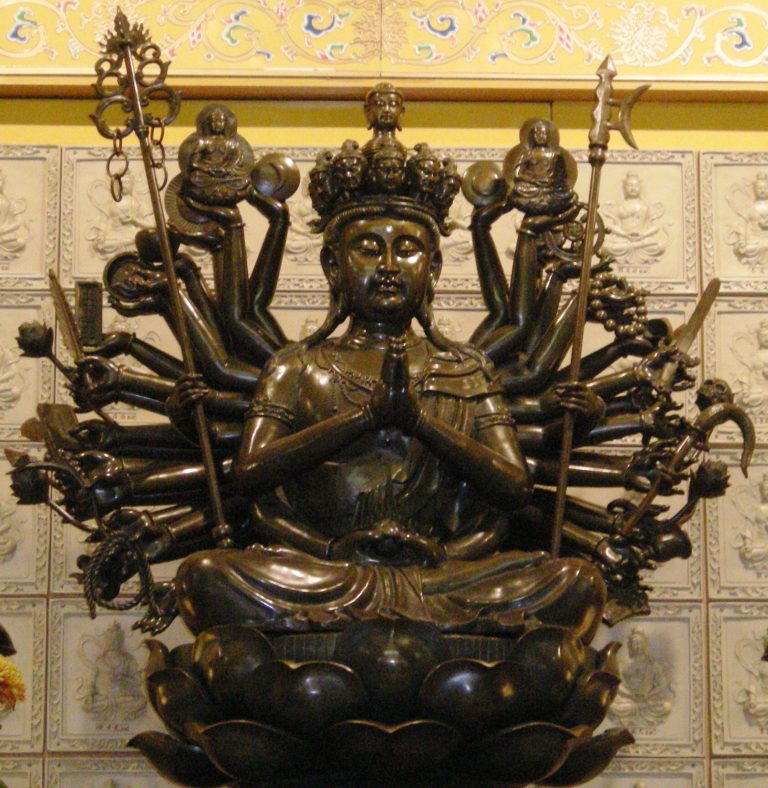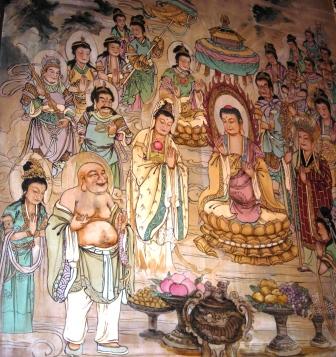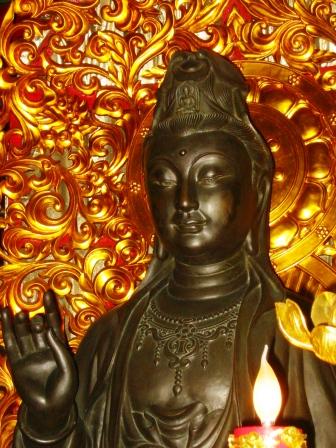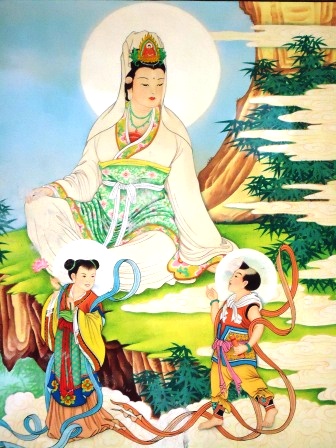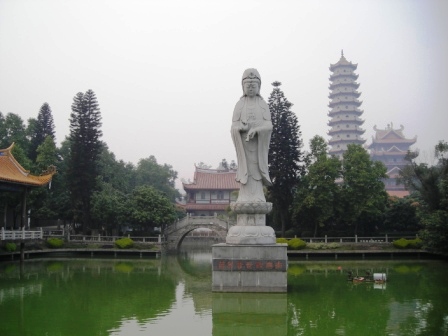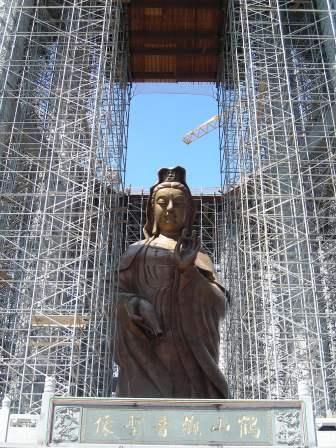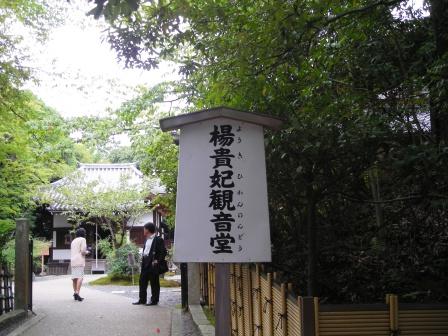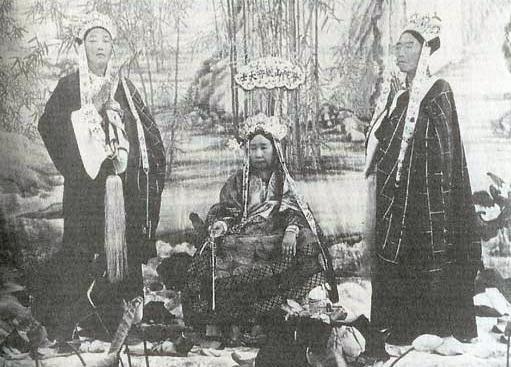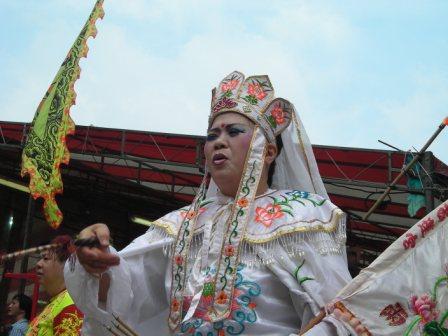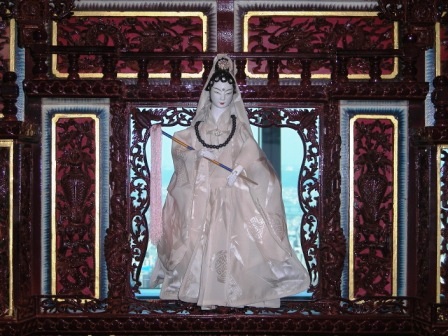
| Home | Chinatowns of the world | Festivals | Culture | Food Culture | History | Countries |
| Chinese Religion | Tours | Sitemap | Documentaries | About | Contact |
Guan Yin 观音菩萨
Guan Yin through the agesThe Bodhisattva was introduced into China via the Silk Road and initially, Guan Yin was presented in male form. As Buddhism became localized in China, Guan Yin was sinicised and subsequently transformed into Chinese female form. Xuan Zang,玄奘, the Tang pilgrim monk who sought Guan Yin’s protection and help as he journeyed to India, had proposed Guan Zi Zai, 观自在, as the correct Chinese translation of Guan Yin’s name. However, it seems like Guan Shi Yin, 观世音, hearer of all sufferings, was a more popular version. When the second Tang Emperor Li Shi Min, 李世民, ascended the throne, Guan Shi Yin was “renamed” as Guan Yin due to the Chinese custom of avoiding characters similar to an Emperor’s name; Shi , 世, in this case. By the Song dynasty, Guan Yin evolved into a female bodhisattva in white robes that we see today. The male Guan Yin continues to be depicted albeit less frequently. The bodhisattva’s gender is unproblematic to devotees as Guan Yin will manifest in any form to reach out or to help suffering beings. Transformations of Guan YinGuan Yin can be identified in sculptures and paintings through a distinct Buddha in her crown. It was said that Guan Yin vowed to save all beings from suffering and if she is unable to do so, she would shatter to a thousand pieces. When Guan Yin realized the immerse suffering, she shattered. Amitabha Buddha, 阿彌陀佛, helped to motivate Guan Yin and henceforth, a small sculpture of Amitabha Buddha is seen in her crown. Guan Yin is depicted in many forms some inspired by miracles attributed to her. The most common is of course the white robe lady. Other popular forms include Water moon Guan Yin, 水月观音, Purple Bamboo Guan Yin, 紫竹观音, Guan Yin of the South Seas, 南海观音, Guan yin with a fish basket, 鱼蓝观音 and Guan Yin as giver of children, 送子观音. There is also the story of Princess Miao Shan , 妙善公主, that told of her life as a compassionate princess. Guan Yin is also manifested as the multiple or the most common thousand arm Guan Yin, 千手观音, a symbol of her aspiration to reach out to any being in any form to help them. In the novel Journey to the West, Guan Yin was the mentor to the Monkey God as he protects and escort the Pilgrim Monk to collect scriptures in India. Guan Yin and Mahasthamaprapta Bodhisattva, 大勢至菩萨, are assistants to the Amitabha Buddha and appear by his side. In this form, they are known as the Three Saints of the Western Paradise,西方三圣. Guan Yin can be identified through the Amitabha Buddha sculpture in her crown while Mahasthamaprapta Bodhisattva has a vase in the crown. When Guan Yin appears with two Bodhisattvas, Wenshu (Manjusri, 文殊) and Puxian (Samantabhadra, 普贤菩萨), by her side, they are known as the Three Saints, 三大士. Guan Yin also has two young assistants; Dragon Lady and Shan Cai (龙女, 善才). Guan Yin and the MadonnaIt has been suggested that Guan Yin with a child was inspired by the Catholic icon of the Madonna. However, Guan Yin with a child appeared in China during the Song dynasty while the association between Guan Yin with Madonna occurred during the late Ming dynasty when traders bought Blanc De Chine sculptures from Dehua region and some of them featured the Guan Yin with a child. The association is therefore incorrect. Worship of Guan YinIn most Buddhist monasteries, there is a Guan Yin hall 观音殿 dedicated to her. There are also many temples dedicated to her and they are usually known as Guan Yin Temple(观音庙, 观音堂,观音庙) with her sculpture occupying the central shrine. These temples can have Buddhist or Taoist origins. There are also sintuas (shrines) dedicated in her honor where the spirit of Guan Yin is manifested through a spirit medium. Devotees pray to Guan Yin for help during crisis, for protection during difficult times of their lives and also as a sign of respect to her. While Guan yin reaches out to help all beings, her ultimate aim is to help them towards their enlightenment. The most popular times to visit Guan Yin temples are 1st and 15th of each lunar month and also three special dates relating to Guan Yin’s birth (19th day of 2nd lunar month), (19th day of 6th lunar month) enlightenment and renunciation (19th day of 9th lunar month) (圣诞, 成道, 出家). Many devotees turn vegetarian for at least a day as an act of devotion and compassion. The main pilgrimage site for Guan Yin is the Putuo Island, 浙江南海普陀山, in Zhejiang Province, China a few hours’ drive from Shanghai. One of the most famous souvenirs on Putuo Island is a pastry known as the Guan Yin pastry,观音饼, inspired by a miracle. In Kek Lok Si, Penang, there is a 30.2 meters tall standing bronze Guan Yin inside an 82.7 meters pavilion. Meanwhile, Hainan Island in China has the world’s tallest Guan Yin at 108 meters. Associations with Guan YinGuan Yin as a great Bodhisattva has been an inspiration for people through the ages and as a result many were associated with her. According to the Japanese, Lady Yang Gui Fei did not die during her escape to Sichuan. Instead, she fled to Japan and was known as Yokihi. In, Kyoto, there is a temple Sennyu-Ji Temple, 泉涌寺, who claims to have a Guan yin sculpture carved in the likeliness of Lady Yang. It is considered a national treasure and the shrine is known as the Lady Yang Guan Yin hall, 杨贵妃观音堂. In Journey to the West, Guan Yin was the mentor to the Monkey God escorting Xuan Zang to colect Buddhist scriptures from India. Closer to our time, the Empress Dowager Cixi loved to dress as Guan Yin whenever she felt unhappy or angry. She had also believed that many looked upon her as a all merciful person like a Guan yin. During a visit to the Summer Palace, she took a photo of herselves dressed as Guan Yin. Even food is related to Guan Yin. A famous Chinese tea Oolong is called Tie Guan Yin or Iron Guan Yin. Its semi fermented tea leaves has a greenish tone similar to iron ores while the way the tea leaves curls looks like the palm of Guan Yin closed in prayer hence its name Iron Guan Yin. Another story claimed that the name was acquired because Guan Yin had directed a tea farmer to discover the tea tree. Spirit of CompassionWith Guan Yin present in so many dimensions of Chinese and Asian culture, it is not difficult to see how popular the Bodhisattva is. But more important to many devotees is the assurance, help and comfort when Guan Yin reaches out to them during the most difficult times of their lives. Guan Yin like other Buddhist Bodhisattvas reaches out without preconditions, without attachments and in forms that one can relate to. There is probably no way to know how many beings have been helped by Guan Yin. On the other hand, the temples and sculptures constructed in her honor and the charities founded in her name give us a clue.
References: Chün-fang Yü (September 15, 2000) Kuan-yin: the Chinese transformation of Avalokitesìvara. Columbia University Press; First Printing edition Related articles:
|
|
| Join us on | Youtube | |||
| Copyright © 2007-24 Chinatownology, All Rights Reserved. | ||||
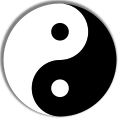 Taoism Main page
Taoism Main page